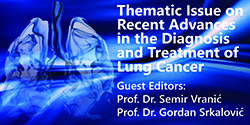Investigation of Correlation between Resistance to Diazepam and Expression of Inflammatory Markers in The Peripheral Blood of Patients with Status Epilepticus
DOI:
https://doi.org/10.5644/ama2006-124.423Keywords:
Diazepam Resistance, HMGB1, GFAP, Interleukin, Status Epilepticus, TLR4Abstract
Objective. This study investigated several inflammatory markers’ gene and protein expression in status epilepticus (SE) and their correlation with diazepam resistance.
Materials and Methods. Peripheral blood samples were collected from 18 adult patients with SE in Cipto Mangunkusumo Central Hospital, consisting of 12 diazepam-responsive and six diazepam-resistant samples, within 72 hours of the onset of the seizure. We collected baseline demographic and clinical data from each subject. Peripheral blood mononuclear cells (PBMCs) were isolated, cultured, stimulated with lipopolysaccharide (LPS) 1 mg/ml, and harvested for RNA isolation. The RNA was used to determine the expression of Human Mobility Group Box 1 (HMGB1), Inter- leukin-6 (IL-6), IL-10, Toll-like Receptor 4 (TLR4), and Glial fibrillary acidic protein (GFAP). In addition, we performed serum protein assay of HMGB1, IL-6, IL-10, TLR4, and GFAP to compare with gene expression.
Results. We found a significant differ- ence between the responsive and resistant groups for serum HMGB1 and IL-6 concentration. The mRNA expression of HMGB1 and IL-6 was significantly higher in LPS-stimulated samples in the responsive but not in the resistant groups. The ratio of IL-6 to IL-10 showed a significant difference between LPS and control in the responsive group. Diazepam response was significantly correlated with seizure duration and serum protein concentration of HMGB1.
Conclusion. HMGB1 was highly expressed in the resistant group and strongly correlated with diazepam response, and there was a significant increase in HMGB1 mRNA expres- sion in response to LPS stimulation. These findings suggest that targeting HMGB1 may be a promising therapeutic strategy and that HMGB1 levels could be a valuable biomarker for predicting diazepam resistance in SE.
Downloads
Published
Issue
Section
License
Copyright (c) 2023 Corry Novita Mahama, Melva Louisa, Fitri Octaviana, Dwi Anita Suryandari, Astri Budikayanti, Heri Wibowo

This work is licensed under a Creative Commons Attribution-NonCommercial 4.0 International License.






